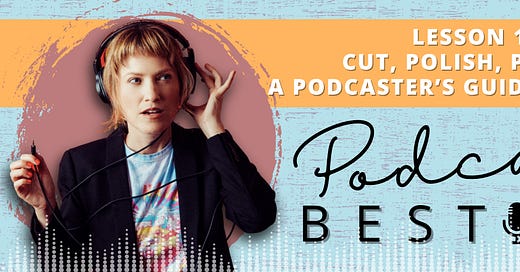Hey Besties,
Editing is where the podcasting magic really happens. It’s the invisible hand that transforms a raw conversation into a compelling, polished piece of audio—dare I say, art? You might have amazing content, but without thoughtful editing, even the brightest ideas can get lost in the noise—literally and figuratively.
The best podcasts aren’t just well-recorded; they’re well-crafted in post. Editing is where you tighten the pacing, amplify emotional beats, and shape your story so it lands with maximum impact—or at the very least, clean up the tape so everyone sounds their best.
Today we’re diving into both sound and story editing—the two sides of the post-production coin. Whether you’re producing interviews, narrative pieces, or solo episodes, this is your best opportunity to level up your show and stand out in the crowded podscape.
🎧 Sound editing: Do. Not. Skimp.
Let’s be clear: you can’t afford to ignore sound editing. It’s one of the most effective ways to separate yourself from the sea of amateur audio. Most podcasts that sound polished and effortless? They’ve gone through a meticulous editing process behind the scenes. You don’t need to be an audio engineer—but you should learn some key basics.
Here’s how to clean up your tape:
✂️ Sound editing checklist
Start with a rough cut. I personally use Descript—it lets you edit from both a transcript and a waveform. (If editing intimidates you, Descript is a game-changer.) As you go, keep this checklist in mind:
🚫 Remove nonfunctional vocal fillers: "um," "uh," "like," "you know"
🗣 Cut false starts, repeated words, awkward phrasing
🔇 Trim gaps between questions and answers
🥱 Snip tangents that aren't funny, interesting, or relevant
💨 Delete distracting breaths, mouth noises, and background sounds
📅 Remove outdated or irrelevant info
😬 Watch for anything culturally insensitive (unless included with intentional context and/or for journalistic purposes)
Clean up as much as you can, but keep some natural rhythm—don’t over-edit into robotic territory.




